Joining the Cocktail Circuit: Social Movement Organizations at the European Union
Although social movement organizations have established themselves successfully on the European level, there is dispute whether the European Union is conducive or detrimental to movement politics. One view is that the EU's particular opportunity structures and styles of policy making subvert unconventional forms of action and participation, thus transforming social movements into a fragmented field of individual interest groups and lobbies. This article critically assesses this perspective. It traces these processes, showing that they were indeed part and parcel of the gradual Europeanization of social movements during the 1970s and 1980s. It then presents evidence that, in the aftermath of the Single European Act of 1986, the European movement sector began moving towards a more integrated multi-level structure. Data drawn from interviews with Euro-level movement activists and EU functionaries present a picture of this new interorganizational structure and multi-level action forms with reference to the European groups working on environmental protection, and human and social rights. It is argued that the present developments stress sectorial and cross-sectorial networking, self-regulation, and common policy deliberation.

